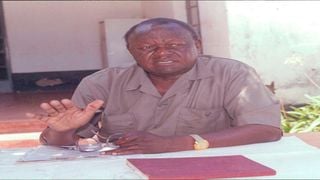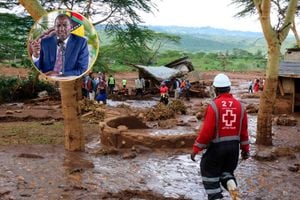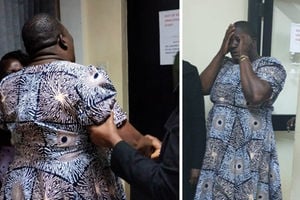
Former Bunyala's independence MP and Jomo Kenyatta government Cabinet minister James Osogo.
| File I Nation Media GroupPolitics
Premium
James Osogo: Political trailblazer’s journey through Kenya’s turbulent history
Before his death on Monday, what came to mind whenever one conversed with James Charles Nakhwanga Osogo is Shakespeare’s words in As you like it:
“All the world’s a stage, And all the men and women merely players; They have their exits and their entrances; And one man in his time plays many parts…”
During this 2018 interview at his Kilimani home in Nairobi, Osogo is clearly an elder statesman and evidence of this is a dotting granddaughter who won’t let the old man alone.
Clearly, the young girl is unaware of the fact that her grandfather is a pioneering political leader, one who contributed greatly in shaping the theatre that is Kenya’s political sphere.
Osogo fought many a political battles and stuck out his neck sometimes in the most charged of circumstances in Kenya’s history. In 1975, for instance, following the death of Nyandarua North MP Josiah Mwangi Kariuki, Osogo, who was the Minister for Health, led the government’s attempt to scuttle the Parliamentary Select Committee’s report that had implicated Police Commissioner Bernard Hinga and General Services Unit Commandant Benjamin Gethi in the murder.

Mr James Osogo (centre), as Minister for Commerce and Industry, is shown the workings of a Philips machine by Mr F J Philips, head of the worldwide organisation.
The Busia South (now Bunyala) MP moved a motion urging the House to “…note and understand rather than accept the report”. This amendment was defeated as MPs were so incensed that they could not entertain anything that would water down the motion.
In the 2018 interview, Osogo explains the circumstances under which he moved the amendment thus: “I had no ulterior motives. All I wanted was to save the Mwangale report. What had happened was that an initial report which I happened to have seen had many more names (of people implicated) compared to the one that Mwangale presented in parliament. It appears that Mwangale had been forced to withdraw the first report because names of some very senior politicians were in but some of us had seen this very report.”
Whether it was because of his taking a pro-Government line at a time when the mood in Parliament and elsewhere was anti-Government remains a matter of conjecture. What is for sure is that in the post-JM murder period, his political stock appreciated, with a major boost to his career being the elevation to the position of Deputy Leader of Government Business in the House.
Osogo was born in the little village of Bukani in Bunyala district in 1932, the second born in a family of 10. He was raised in a strict Catholic family, his father having been an official of the local church.
Indeed, he says that as a child, his first career of choice was to be a priest and his eyes were fixed on joining a seminary but this was not to be as he ended up at St Mary’s School Yala, the famous Catholic-church-sponsored institution that nurtured many a talent in Kenya’s formative years. Indeed, his contemporaries included Mboya.
After school, he had a lingering ambition for the military, specifically the Royal Navy, but opportunities in this area were scarce, thus he took an opportunity to serve in the East African Railways — a major source of employment then. This entailed training at the East African Railways and Harbours Institute, today, the Kenya Railways Training Institute in Nairobi.
If Osogo’s political consciousness particularly against the colonialists had been pricked while at St Mary’s School Yala, joining the Railway Training Institute brought him face to face with the brutal face of imperialism. He would witness and participate in the riots called by such fiery trade union leaders as Markhan Singh and Kung’u Karumba.
On completion of his studies, he was employed as assistant station master serving at various railways stations in Kenya and Uganda. “This gave me an opportunity to traverse the two countries in the course of which I met and interacted with very many people”, he recalls. He, however, says his heart was never really in Railways but his passion was in teaching, “which for me was the closest thing to politics since in teaching, you impart knowledge and influence people towards development.”
What accelerated his departure from the railways service were the many instances of discrimination against Africans — many of which he could not stomach — and got involved directly. He recalls many occasions when he had a run in with the colonial railways management.

Jomo Kenyatta-era minister James Osogo (right) and Busia Governor Paul Otuoma.
Thus in 1953, Osogo sought and got admission to Kagumo Teachers Training College from where he would graduate three years later. Like the East African Railways and Harbours Institute, Kagumo had the effect of expanding his knowledge of Kenya’s leadership challenges at the time, mainly the Mau Mau uprising and the fact that Kagumo was in the heartland of Kikuyu country where a brutal purge was going on.
After graduation, Osogo was posted to Sigalame Intermediate School in his Busia home district where he entered politics, serving as a councillor in the Nyanza African District Council.
He thus doubled as both a teacher and a councillor at the relatively young age of 24 years. This was not to last, however, as two years later the District Council was dissolved ostensibly because Osogo and his colleagues were very critical of the colonial administration.
In 1959, Osogo was transferred to Port Victoria Intermediate School, on the shores of Lake Victoria, a much more urbanised area. This is also the year he married his first wife, Maria.
His stay at Port Victoria would however be short-lived as within the year, he had run afoul of the colonial administration, especially by being outspoken about the fishing rights of his Bunyala people.
“The colonialists wanted to dominate and monopolise fishing in Lake Victoria. As nobody was coming out strongly enough to defend the rights of the locals, I decided that I would stand up for the rights of my people,” he says in the interview.
For his fishing rights agitation, the colonial administration rewarded him with a transfer to Kabasaka Intermediate School in Nandi District, banishing him from close interaction with his people.
“This infuriated me but I took it in my stride, knowing that in my plans, the transfer would be a temporary stop before going on to serve the people on a full-time basis,” he says.
When Kanu was formed in 1960, Osogo was one of the first people to join the party. He would show independence of mind by sticking with Kanu even when his native Luhyaland was more inclined to Kadu, in part because one of its leading lights was Muliro, who was then the sole representative of Elgon Nyanza (Western Province) in the Legco .
“I felt very strongly that we needed a national party that would bring together all Kenyan people as a force to defeat the colonialists and felt that divisions would make us weak,” he explains the reasons why he sidestepped Kadu.

Former minister James Osogo with his family. Mr Osogo died at Aga Khan Hospital on august 15, 2023.
Thanks to the passing of the Lancaster Constitution in 1961, elections were called throughout the country. Osogo’s Bunyala region was in Central Nyanza District and at elections attracting eight candidates, he thought he had a chance.
When the results were in and counted, however, he had come in at number three after Odinga and Kodhek. After the elections, he lobbied for nomination by Kanu but the slot went to Walter Odede instead, even though Osogo had entertained the thought that as one of the foremost Luhya contestants, he would be considered over a Luo politician.
Across the party lines, Kadu nominated Peter Habenga Okondo, the man who would be Osogo’s nemesis.
Political reforms
The first major salvo in the Osogo-Okondo duel was to be played out in 1963 as part of the comprehensive political reforms accompanying Kenya’s independence. In the battle for Ruwambwa constituency, Osogo emerged victorious, notwithstanding the fact that Okondo had had a head start as a nominated MP in the previous Parliament, as well as being the more educated of the two men.
Okondo boasted of a Bachelor of Commerce degree from the University of Cape Town and had served as a senior government official in the Ministry of Finance in Uganda.
As soon as he made his debut in Parliament, Osogo was appointed Agriculture Ministry Parliamentary Secretary or assistant minister in the current set up. The substantive Agriculture Minister was Bruce Mackenziee.
When the relationship between President Kenyatta and Vice President Odinga turned from one of comradeship to sworn enemies, Osogo was to be a beneficiary in the 1966 reshuffle; he replaced Oneko at the Information and Broadcasting ministry.
The Osogo-Okondo battle was replayed in 1969. Osogo would once again trounce Okondo but with the thin margin of 600 votes. Kenyatta appointed Osogo Minister Commerce and Industry.
“Some of the major industries in Kenya today were initiated during my tenure at the ministry,” says Osogo. He lists Pan African Paper Mills, Firestone tyre company (now Yana) and Mumias Sugar Company as examples of the government’s investment in manufacturing under his watch.
From Commerce and Industry, Osogo was moved to the Ministry of Local Government where he oversaw the transformation of many market and urban centres into town councils throughout the country.
In 1974, Okondo made a tactical move and decided not to contest the Busia South seat and instead threw his weight behind one James Ombere Okoch who coincidentally was Osogo’s relative. It would appear that Okondo’s strategy was to erode Osogo’s support by pitting him against a blood relative. The contest was, to say the least, bruising.
Still, Osogo scrapped through with a smaller margin compared to the 1969 elections. On return to Parliament, he was appointed Minister for Health at a time when the sector was going through many difficulties.
Kenyatta National Hospital, the country’s only referral facility then was in a shambles. Medical doctors were threatening industrial action against poor living and working conditions. When Osogo introduced a Bill seeking to regulate medical practitioners, the professionals went defiant.
Osogo used a hands-on approach to address these mounting problems and at the same time oversaw an ambitious expansion of medical facilities throughout the country. Indeed, modern buildings at Kenyatta National Hospital were completed during his tenure as did many provincial and district hospitals countrywide.
When Kenyatta died in 1978, Osogo’s fortunes started to plummet and he found himself facing new challenges. He believes this was one of the reasons he was not in the good books of the new regime.
In the 1979 elections, all indications were that the Moi regime was intent on getting new faces across the nation as Moi sought to consolidate his power base. Many political careers ended abruptly as newcomers with demonstrated loyalty to the new president romped home.
Osogo managed to stave off a spirited battle from his perpetual nemesis, Okondo, and on return to Parliament, was appointed Minister for Agriculture while retaining the Deputy Leader of Government Business position that he had held from June 1975.
If ominous signs that things would not be rosy for Osogo in the new dispensation were discernible everywhere, the clearest indication that he was out of favour of the new regime was in 1980 when his agriculture portfolio was split into two with the creation of the Ministry of Livestock to which he was moved.
Even as his duties and function were being clipped, he had another worry in the form of a petition by a voter who claimed that he had won by administering an oath. Osogo lost his parliamentary seat in 1981 with a heavy price — being barred from contesting the seat for five years.
In the ensuing by-election, Osogo threw his weight behind a retired army officer, William Diffu, against Okondo. But the Kanu party machinery was determined to ensure Okondo made it to Parliament. Diffu was barred from contesting and Okondo sailed through unopposed.
Okondo would win again in 1983 and 1988 against Osogo. When Okondo won the latter elections, however, Osogo petitioned and ironically pointed out oath taking as the main ground. The court dismissed the petition.
Not long after this, Okondo, known for public gaffes, was involved in an altercation with outspoken Anglican prelate, Alexander Muge. When Muge died shortly after being threatened with death by Okondo, public pressure was so high that Okondo had no choice but to resign from his ministerial position.
When the multiparty wave gained momentum in the late 1980s and early 1990s, Osogo joined Ford Kenya and became the party’s Busia branch chairman. However, he did not stay long in the opposition as he was convinced by Moi to rejoin Kanu.
“I was all for the Opposition but when the main opposition leaders could not agree to field one candidate against Moi, I had to be realistic. I knew that divided they would not beat Moi,” says Osogo.
He easily won the Bunyala seat (formerly known as Busia South) and on return to Parliament after a decade hiatus, he was appointed Assistant Minister for Commerce. This was clearly against his expectations of coming back as a Cabinet minister.
In 1997, Osogo was, with Achieng Oneko, the co-chairman of the Inter Parties Parliamentary Group (IPPG) outfit that successfully negotiated minimum reforms before that year’s elections.
During the 2002 elections, however, Osogo lost to newcomer Raphael Wanjala for the now-renamed Budalang’i constituency. After the loss, Osogo hang his political boots.
This article was first published in the Kenya Yearbook Editorial Board




